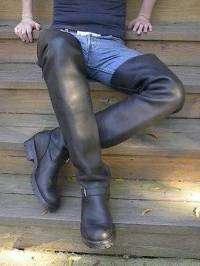Engineer boot


Engineer boots, also known as Engineer's boots, are one of many styles of leather boots; this type of footwear is often worn by motorcycle riders. The boots are most often made of heavy weight black leather, have a rounded or squarish toe and range in height from short (7") to extra high (38"). The most typical height is between 10 and 17 inches.
Description
Engineer boots are designed to protect the wearer from injury to the foot and leg. They may include a built-in steel toe cap and metal shank in the sole, and often are double layered with leather for stiffness. Engineer boots typically have an adjustable leather strap across the ankle as well as an adjustable leather strap at the top of the shaft to adjust the fit. Multiple straps at the top of the shaft are also not uncommon. Soles and heels are usually made of hard rubber and may either be relatively flat or may have lugs for increased traction. The straight solid shaft with few seams could be readily waterproofed for those working in wet environments or around concrete pouring operations. Additionally lack of protruding fittings, nails or laces prevented snagging injury when working around belt drive and line shaft machinery.
History
Origins
Around 1860, The Frye Company produced a popular line of harness boots. Quickly adopted by the United States Cavalry, they featured an ankle strap style that revolved around metal rings which may have served as inspiration for the design of the engineer boot.[1] During the 1930s, Chippewa Shoe Manufacturing Company developed a pair of boots with stovepipe legs and fashioned over their "English Riding Boot" lasts. The West Coast Shoe Company (Wesco) began manufacturing their "engineer boots" in the 1939. Engineer boots were originally meant as protective gear for firemen working on steam railway engines, as their minimal stitching and pull-on design made them ideal for working in conditions with hot coals, embers, and sharp edges.[2][3] This is a probable source of the name.[4] Wesco's boots were immediately popular with welders in Portland, Oregon-area shipyards, who needed looser fitting shoes that they could quickly remove in the event embers landed in the shafts.[1]
On the overall basis, engineer boots were subverted in the shoe market during World War II by the production of lace-up combat boots[3] and demand dramatically decreased for them.[1]
Widespread use
Both Chippewa and Wesco heavily increased sales of the boots in the late 1940s. There was a post-war production boom for the boots, with high demand coming from returning veterans and bikers.[3] The latter adopted engineer boots because the laceless design wouldn't interfere with motorcycle drive belts, the shafts were well insulated from heat, and they provided full lower leg protection in case of an accident.[1] The footwear's popularity was furthered by its use by celebrities such as Marlon Brando and James Dean in their respective films The Wild One and Rebel Without a Cause.[4]
The boots would became heavily associated with the American greasers, British rockers, and bikers that wore them in the 1950s and 1960s.[5][6] The rockers would often wear their boots with white seaboot socks rolled down over the top of the shafts.[7] By the 2010s, engineer boots, along with other industrial footwear, were worn popularly for fashion purposes, especially by non-traditional customers such as women, young professionals, and hipsters.[1]
In popular culture
- Engineer boots were famously worn by Marlon Brando in The Wild One and James Dean in Rebel Without a Cause
- Billy Joel refers to the popularity of the engineer boot in '50s and '60s Greaser culture in his song "Scenes from an Italian Restaurant" with the line "I remember those days hanging out/At the village green/Engineer boots, leather jackets/And tight blue jeans"
See also
References
- 1 2 3 4 5 MacRae, Michael (August 2015). "Engineers Get the Boot". American Society of Mechanical Engineers. Retrieved 14 November 2016.
- ↑ "ENGINEER STYLE NO. 2991". Red Wing Shoes. Red Wing Brands of America, Inc. Retrieved 30 August 2016.
Originally developed for engineers working on America’s railroads, the Engineer Collection’s pull-on styling and minimal stitching was designed to protect their feet from hot embers.
- 1 2 3 Old, Forrest (16 March 2015). "The History of Engineer Boots with John Lofgren". heddels.com. Heddels. Retrieved 12 July 2016.
- 1 2 Boyer, G. (8 September 2015). True Style: The History and Principles of Classic Menswear. Basic Books. ISBN 9780465061594.
- ↑ F., Jose` Blanco (23 November 2015). Clothing and Fashion: American Fashion from Head to Toe (illustrated ed.). ABC-CLIO. p. 137. ISBN 9781610693103.
- ↑ Calderin, Jay (1 December 2009). Form, Fit, Fashion: All the Details Fashion Designers Need to Know But Can Never Find. Rockport Publishers. p. 85. ISBN 9781616736750.
- ↑ Rebecca Whyte (Director) (2014). Timeshift - Mods, Rockers, and Bank Holiday Mayhem (Television production). London: British Broadcasting Corporation.